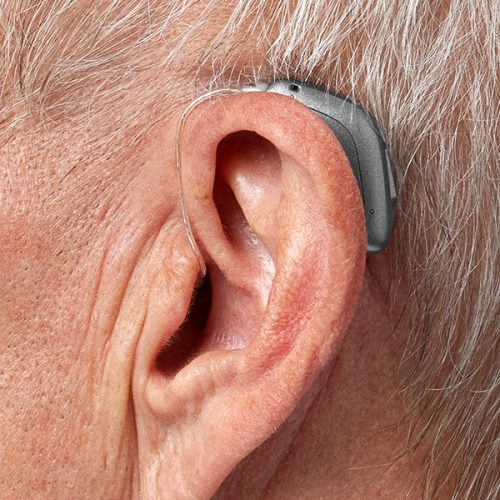At The Centre for Hearing, we tailor solutions to fit your unique needs, ensuring that you never miss a moment again.
At The Centre for Hearing, we’re committed to helping you regain the sounds of life.
BOOK YOUR APPOINTMENTHearing Aids
Hearing aids are sophisticated electronic devices designed to amplify sound for individuals with hearing loss. They consist of a microphone (to capture sound), an amplifier (to increase sound volume), and a speaker (to deliver enhanced sound to the ear). Modern hearing aids also incorporate advanced technologies like digital noise reduction, directional microphones, and Bluetooth connectivity.

Behind-the-Ear (BTE)
- The main body sits behind the ear, with a tube connecting it to a custom-molded earpiece.
Suitable for mild to profound hearing loss.
Offers powerful amplification and durability.
Often includes telecoils and Bluetooth for wireless connectivity.

Receiver-in-Canal (RIC) or Receiver-in-the-Ear (RITE)
- Similar to BTE but smaller, with a thin wire connecting the main body to a receiver inside the ear canal.
- Provides better sound clarity due to the receiver’s placement.
- Less occlusion (plugged-ear sensation) compared to traditional BTEs.

Behind-the-Ear (BTE)
The main body sits behind the ear, with a tube connecting it to a custom-molded earpiece.
Suitable for mild to profound hearing loss.
Offers powerful amplification and durability.
Often includes telecoils and Bluetooth for wireless connectivity.

Receiver-in-Canal (RIC)
Similar to BTE but smaller, with a thin wire connecting the main body to a receiver inside the ear canal.
Provides better sound clarity due to the receiver's placement.
Less occlusion (plugged-ear sensation) compared to traditional BTEs.

In-the-Ear (ITE)
Custom-made to fit the entire outer portion of the ear.
Easier to handle than smaller styles, making it ideal for individuals with dexterity issues.
Can accommodate more features like volume control and directional microphones.

In-the-Ear (ITE) & In-the-Canal (ITC)
- Custom-made to fit the entire outer portion of the ear.
- Easier to handle than smaller styles, making it ideal for individuals with dexterity issues.
- Can accommodate more features like volume control and directional microphones.

Completely-in-the-Canal (CIC)
- ITC fits partially inside the ear canal, while CIC is almost invisible inside the canal.
- Highly discreet but may lack advanced features due to their small size.
- Suitable for mild to moderate hearing loss.

Invisible-in-the-Canal (IIC)
- The smallest hearing aid, placed deep within the ear canal.
- Virtually undetectable but may not be powerful enough for severe hearing loss.
Benefits of Hearing Aids
Hearing aids offer numerous benefits that go beyond simply making sounds louder. They enhance overall well-being, social engagement, and cognitive function.
Improved Speech Recognition
Enhanced Quality of Life
Hearing aids improve communication, allowing individuals to participate in conversations with ease.
Cognitive and Brain Health
When the brain is deprived of sound input, it undergoes auditory deprivation, leading to atrophy of the auditory cortex.
Hearing aids keep the brain engaged, reducing the risk of cognitive decline.
Cognitive and Brain Health
Better Localization of Sound
This is crucial for safety in environments like streets, workplaces, and public spaces.
Tinnitus Management
This can significantly improve concentration and sleep quality.
Wireless Connectivity and Modern Features
Users can stream audio directly to their hearing aids, making phone calls and entertainment more accessible.
Increased Independence
This fosters confidence and autonomy, especially in professional and social settings.



